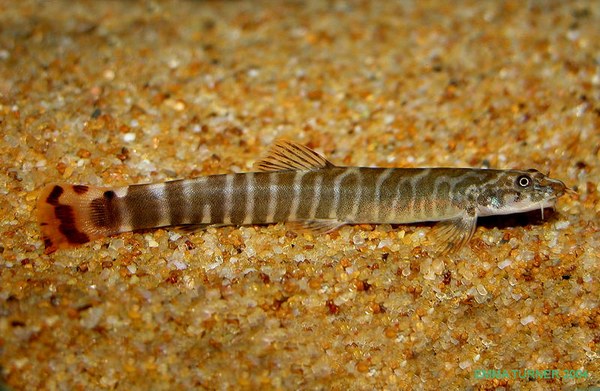Aborichthys elongatus
Summary

Male
Scientific Name: Aborichthys elongatus (Hora, 1921)
Common name: Red Tailed, Striped Sand Loach, Red Tailed Squirrel Loach
Synonyms: Noemacheilus elongatus
Distribution: India
Sexual Dimorphism: Females noticeably plumper in healthy, well-fed fish. Females have more markings on body and less bands in caudal fin.
Maximum size: 3 inches
Similar to: Other Aborichthys species

Female
Care: Inhabit fast flowing rivers over rock, gravel and pebbles. Aquarium should duplicate these conditions, including high water flow, as these fish have high oxygen requirements and appreciate a current. Provide plenty of hiding places under flattish pebbles or slate.
See: Hillstream Loaches: Specialists at Life in the Fast Lane for more detailed explanation of possible tank setup.
Feeding: Easily fed. Accepts good quality flake, sinking pellets, thawed frozen Bloodworm, Mysis Shrimp, Brine Shrimp, chopped salad shrimp, etc.
Water parameters: pH: 6.5-7.5 Hardness: Medium Soft to Medium Max dh:
Temperature: 70ºF to 78ºF (21-25.5°C)
Breeding: Not bred in aquaria.
Notes
 This species can be both entertaining and frustrating. They are highly accomplished diggers and like to excavate places to hide under rockwork. Their excavations can be highly disruptive to the good looks of a carefully set up decorative aquarium. The aquarist should ensure that all rockwork in the aquarium has firm foundations as it is quite possible for these fish to undermine an unstable stack of rock and cause a collapse which could be disasterous.
This species can be both entertaining and frustrating. They are highly accomplished diggers and like to excavate places to hide under rockwork. Their excavations can be highly disruptive to the good looks of a carefully set up decorative aquarium. The aquarist should ensure that all rockwork in the aquarium has firm foundations as it is quite possible for these fish to undermine an unstable stack of rock and cause a collapse which could be disasterous.
They are extremely voracious feeders and will go into a complete feeding frenzy. They will take flake food from the water's surface or zoom crazily around snapping at anything that resembles food. Likely to be of a very high threat to anything that will fit in their mouths, and unnerve placid species.  They will live peacefully with Hillstream Loaches and enjoy similar conditions. If the hobbyist wishes to breed other fish in the tank though, it is likely that the Aborichthys will consume eggs or fry.
They will live peacefully with Hillstream Loaches and enjoy similar conditions. If the hobbyist wishes to breed other fish in the tank though, it is likely that the Aborichthys will consume eggs or fry.
The species will mix with its own kind, even sharing burrows together, but at certain times males may engage in violent fights over territory, often resulting in numerous bite marks on the body. Strangely, the combatants will be seen quite happily sharing the same hole the next day.
Very entertaining fish and easy to keep given the correct conditions as long as their habits can be tolerated.
Photo Gallery
Click to view all images of this species! |
Document Actions


